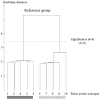Effects of Age and Expertise on Mental Representation of the Throwing Movement Among 6- to 16-Year-Olds
- PMID: 35496147
- PMCID: PMC9039452
- DOI: 10.3389/fpsyg.2022.799316
Effects of Age and Expertise on Mental Representation of the Throwing Movement Among 6- to 16-Year-Olds
Abstract
The aim of this article was to assess the development of mental representation of the overhead throwing movement as a function of age and expertise. The mental representational structure of the overhead throwing movement was measured using the Structural Dimensional Analysis-Motoric (SDA-M) method that reflects the organization of basic action concepts (BACs). BACs are fundamental building blocks of mental representations, which comprise functional, sensory, spatiotemporal, and biomechanical characteristics of a movement (Schack, 2010). In this study, novices and handball athletes (N = 199) each were grouped according to the level of development in motor ontogenesis (in childhood, pubescence, and adolescents). Male and female handball athletes played in the highest leagues of their age groups. As a result, novices of all age groups showed the same unstructured mental representation. Athletes in the earliest age band resemble all novices' groups and showed similar unstructured mental representation, whereas athletes within pubescence and adolescents showed functionally well-structured representations, which were similar to the structure of the reference group (N = 8). These results are consistent with a previous investigation of related quantitative and qualitative performance parameters of the overhead throwing movement (Gromeier et al., 2017). Without an increased training, neither the throwing performance nor the associated mental representation is unlikely to improve further by itself or automatically.
Keywords: SDA-M; cognitive performance; mental representation; motor skill development; movement expertise; overarm throwing motion; throwing movement.
Copyright © 2022 Gromeier, Schack and Koester.
Conflict of interest statement
The authors declare that the research was conducted in the absence of any commercial or financial relationships that could be construed as a potential conflict of interest.
Figures







References
-
- Ahnert J. (2005). Motorische Entwicklung vom Vorschul- bis ins Frühe Erwachsenenalter: Ein-Flussfaktoren und Prognostizierbarkeit. München: Verlag Deutsches Jugendinstitut.
-
- Barela J. (2013). Fundamental motor skill proficiency is necessary for children’s motor activity inclusion. Motriz 19 548–551.
-
- Bläsing B., Tenenbaum G., Schack T. (2009). The cognitive structure of movements in classical dance. Psychol. Sport Exerc. 10 350–360.
LinkOut - more resources
Full Text Sources
Research Materials

